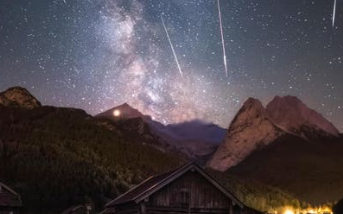Stargazers are about to get a show…
Get ready for one of the year’s most dazzling celestial displays as the Perseid meteor shower kicks off this July. Recognized as the best meteor shower of the year by NASA, the Perseids began on July 14 and are set to peak on the night of August 12 into the early morning of August 13.
Perseid meteor shower returns to our skies this month to kick off summer ‘shooting star’ season https://t.co/wFnEoXZCX8
— Hedgewic 🏴🇬🇧 (@Hedgewic) July 14, 2024
Joe Rao of Space.com reports that the first meteors typically appear in the latter part of July, with sightings increasing into the second week of August. Daisy Dobrijevic of Space.com notes that 2024 is an especially favorable year to observe the Perseids. Although the moon will be 50% illuminated, it will set at midnight on August 12, providing darker skies perfect for meteor viewing until dawn.
During its peak, the Perseid shower can produce 50-100 “fast, bright meteors” per hour, according to Rao. These meteors, described by NASA as “swift and bright,” leave long trails of light and color as they streak through the sky. A few “straggler” meteors may still be seen as late as August 18.
The Perseid Meteor Shower Begins Today: When To See It At Its Best https://t.co/daCWBzwBHS
— Barbara (@MissZena2009) July 14, 2024
The name “Perseids” comes from the Perseus constellation, which is the radiant point where the meteors seem to originate. However, the actual source of the shower is debris from the comet 109P/Swift-Tuttle.
No special equipment is needed to enjoy the Perseid peak on August 12. Meteors will be visible to the naked eye, says Dobrijevic. The best way to view the shower is to find a dark location, lean back, and watch as much of the night sky as possible. NASA recommends viewing in the pre-dawn hours for the best experience, though meteors could be visible as early as 10 p.m.
For more information on the Perseid meteor shower and how to observe it, visit NASA’s and Space.com’s websites.
Key Points:
i. The Perseid meteor shower, considered the best of the year, started on July 14 and will peak on the night of August 12 into the early morning of August 13.
ii. The peak viewing conditions are favorable this year, with the moon setting at midnight on August 12, leaving darker skies for meteor spotting.
iii. During the peak, observers can expect to see 50-100 meteors per hour, known for their bright and fast trails.
iv. The meteors originate from debris left by the comet 109P/Swift-Tuttle, not the Perseus constellation.
v. Viewing is best in the pre-dawn hours with no special equipment needed, just a dark location and a clear view of the sky.
Charles William III – Reprinted with permission of Whatfinger News



